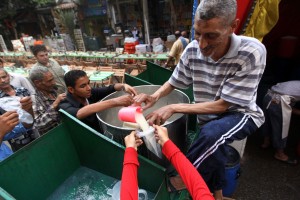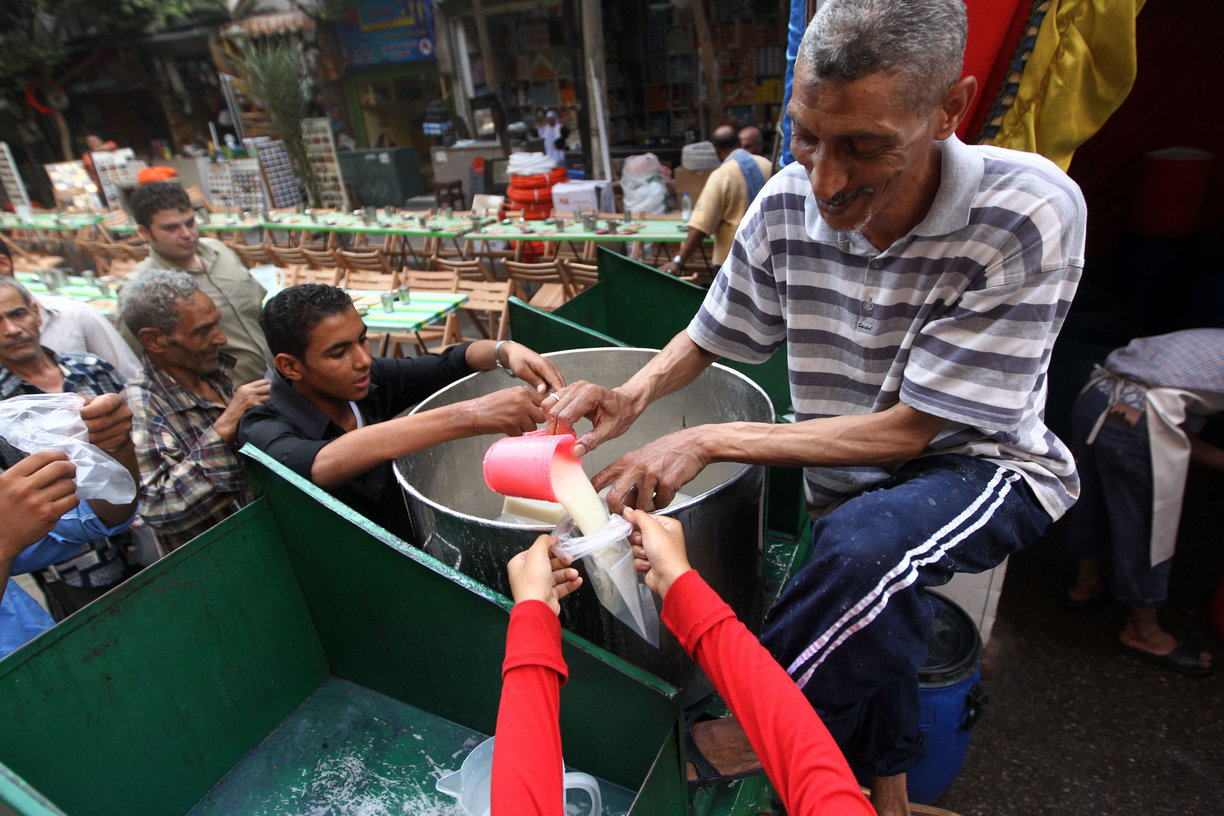
AFP PHOTO / KHALED DESOUKI
There’s no avoiding that it’s hot in Egypt. It’s hot in summer, it’s hot in winter, and I’d add more seasons but that’s all we have: hot and slightly less hot. Ramadan really hammers this fact home by not allowing your tongue to touch a drop of water until a quarter past dehydration. In light of this we’ve decided to compile a list of drinks you should be downing by the gallon once the sun sets to adequately hydrate yourself for the next day. All of the following are traditional Ramadan drinks that you’re sure to find almost anywhere, whether in fancy glasses in restaurants, or plastic bags with straws on the street.
Amar El Din is a traditional Ramadan drink which – in my opinion – should be available year round. Made from either rolled dried apricot or dried apricot paste, the drink comes in a variety of consistencies from treacle-thick to water-thin. As well as tasting delicious, it contains a host of digestive aids, metabolism regulators, vitamins, and other useful ingredients. Physician and philosopher Avicenna (known in the Arab world as Ibn Sina) rightly praised dried apricots as thirst quenchers and antidotes to diarrhea. Who knew?
Next comes my personal favourite, karkadeh. Karkadeh is commonly known as hibiscus, and is usually served hot like tea or cold, though with a hearty iftar meal the cold version is preferred. Once again, it comes with a heap of interesting and useful side effects such as regulating blood pressure. My personal favourite thing about karkadeh? The karkadeh-flavoured shishas that you can find at one out of every ten cafes. Interestingly enough, karkadeh is said to be the preferred drink of the pharaohs so be sure to serve it in a sufficiently regal-looking glass.
If you don’t like the sweetness that comes with so many of these drinks, then perhaps tamr hendy (or tamarind) is for you. This drink made from the so-called “Indian date” is quite sour when prepared correctly and served chilled. If you’re lucky, you’ll catch one of the street vendors tipping over an elaborate brass or aluminium contraption as he pours out plastic cups full of this thirst quencher for passersby.
Another throwback to the pharaohs, kharroub is a cold drink made from the fruit of the carob tree. It’s a bit of an acquired taste but the fact that it is said to reduce cholesterol will no doubt come as welcome news to many. According to reliable sources, the best kharroub can be found in the coastal city of Alexandria.
Sobia is the Egyptian equivalent of the preferred chocolate milk brand favoured by kids everywhere. Adorning most children’s lunch tables at school, this is the thirst-quencher. Ideally an icy frothy mix of coconut, milk, cinnamon and a whole host of assorted other secret ingredients depending on who you ask, sobia is reminiscent of a melted vanilla milkshake only miles better and a gift from above in the weather we’re currently experiencing. For the absolute best sobia, find someone selling it in plastic bags in the street… if your system can handle it that is.
Erk sous is made from liquorice root and admittedly does not look delicious at first glance. However, it tastes exactly how you’d expect it to, so avoid it if you don’t like liquorice and if you’re not sure, try it first. When it comes to health benefits it cannot be beaten, and does everything from treating nausea and stomach pains to staving off fatigue and helping with constipation. It is a true miracle worker, and much like tamr hendy, Turkish-style street vendors wheel elegant contraptions with long spouts around to ensure it is accessible to you.
As always, the list is too short and there are those who deserve at the very least an honourable mention, so let us not forget sahlab, an eclectic mix of ingredients topped with nuts and served hot, asab or sugarcane juice, that staple of Egyptian juice shops that can calm your stomach and refresh your entire being any day of the year and finally watermelon juice which has become so popular that upon asking for it at cafes, the default answer is ‘no’, with a ‘yes’ eliciting cries of joy that echo across the capital.




